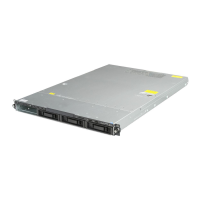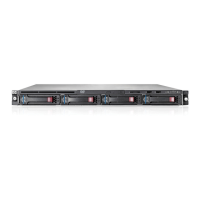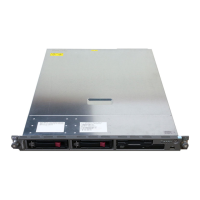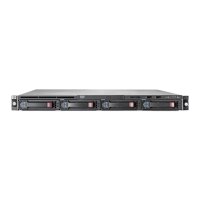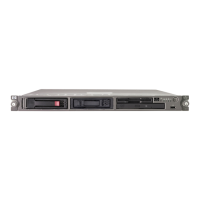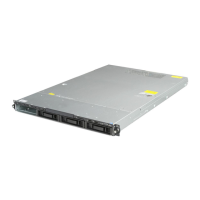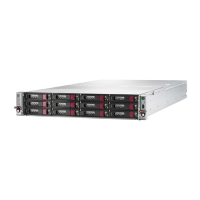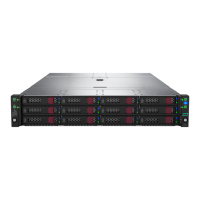Do you have a question about the HP AMS DL320 and is the answer not in the manual?
Identifies and describes front-panel components, including LEDs and buttons.
Identifies and describes rear-panel components, including ports and LEDs.
Details components located on the system board, including switches and connectors.
Explains system and internal health LED statuses for diagnosing issues.
Procedures for powering the server up, down, and into standby mode.
Steps for preparing the server for access, including extending and removing from a rack.
Instructions for removing and installing the server access panel for internal access.
Steps for removing and installing PCI riser board assemblies and fan assemblies.
Guidelines for optimal server placement, including space, airflow, temperature, power, and grounding.
Information and warnings related to installing the server into a rack safely.
Guidance on connecting peripheral cables and power cords to the server.
Steps for powering up, configuring the system, and installing the operating system.
Guidelines and procedures for installing memory modules (DIMMs) into the server.
Procedures for removing and installing hard drives and drive blanks.
Steps for installing optional optical and diskette drives into the server.
Procedures for installing expansion boards and optional storage controllers.
General principles and precautions for routing server cables to optimize performance and airflow.
Introduces SmartStart, RBSU, and other utilities for server configuration and deployment.
Covers tools like ASR, ROMPaq, iLO, Erase Utility, and HP SIM for server management.
Details utilities like HP Insight Diagnostics and Survey Utility for system analysis and troubleshooting.
Information on updating drivers, ROM, and firmware using PSPs and other utilities.
Guide to obtaining resources and initiating the troubleshooting process with diagnostic steps.
Important safety information and precautions before performing diagnostics or handling components.
Guidance on collecting symptom information and checking for loose connections.
Provides flowcharts for diagnosing power-on, POST, OS boot, and server fault issues.
Step-by-step instructions for replacing the server's real-time clock battery.
Details FCC rules, Class A/B equipment, and declarations of conformity for US users.
Compliance information for Canada, European Union, Japan, BSMI, and Korea.
Notices regarding laser safety, battery handling, and electronic waste disposal regulations.
Awareness and precautions to prevent damage from static electricity to system components.
Describes various methods and tools for proper grounding when handling sensitive parts.
Details operating and shipping temperature ranges, and humidity requirements.
Provides dimensions, weight, power input, and output specifications for the server.
Lists related documentation and provides HP contact details for support and service.
Explains HP's program for shipping replacement parts for user replacement.
Identifies and describes front-panel components, including LEDs and buttons.
Identifies and describes rear-panel components, including ports and LEDs.
Details components located on the system board, including switches and connectors.
Explains system and internal health LED statuses for diagnosing issues.
Procedures for powering the server up, down, and into standby mode.
Steps for preparing the server for access, including extending and removing from a rack.
Instructions for removing and installing the server access panel for internal access.
Steps for removing and installing PCI riser board assemblies and fan assemblies.
Guidelines for optimal server placement, including space, airflow, temperature, power, and grounding.
Information and warnings related to installing the server into a rack safely.
Guidance on connecting peripheral cables and power cords to the server.
Steps for powering up, configuring the system, and installing the operating system.
Guidelines and procedures for installing memory modules (DIMMs) into the server.
Procedures for removing and installing hard drives and drive blanks.
Steps for installing optional optical and diskette drives into the server.
Procedures for installing expansion boards and optional storage controllers.
General principles and precautions for routing server cables to optimize performance and airflow.
Introduces SmartStart, RBSU, and other utilities for server configuration and deployment.
Covers tools like ASR, ROMPaq, iLO, Erase Utility, and HP SIM for server management.
Details utilities like HP Insight Diagnostics and Survey Utility for system analysis and troubleshooting.
Information on updating drivers, ROM, and firmware using PSPs and other utilities.
Guide to obtaining resources and initiating the troubleshooting process with diagnostic steps.
Important safety information and precautions before performing diagnostics or handling components.
Guidance on collecting symptom information and checking for loose connections.
Provides flowcharts for diagnosing power-on, POST, OS boot, and server fault issues.
Step-by-step instructions for replacing the server's real-time clock battery.
Details FCC rules, Class A/B equipment, and declarations of conformity for US users.
Compliance information for Canada, European Union, Japan, BSMI, and Korea.
Notices regarding laser safety, battery handling, and electronic waste disposal regulations.
Awareness and precautions to prevent damage from static electricity to system components.
Describes various methods and tools for proper grounding when handling sensitive parts.
Details operating and shipping temperature ranges, and humidity requirements.
Provides dimensions, weight, power input, and output specifications for the server.
Lists related documentation and provides HP contact details for support and service.
Explains HP's program for shipping replacement parts for user replacement.
| Product Name | HP AMS DL320 |
|---|---|
| Form Factor | Rack-mountable |
| Processor Socket | LGA 1155 |
| Maximum Memory | 32 GB |
| Memory Slots | 4 |
| Processor | Intel Xeon |
| Storage Controller | HP Smart Array |
| Drive Bays | 4 LFF or 8 SFF |
| Operating System Support | Windows Server, Linux |

